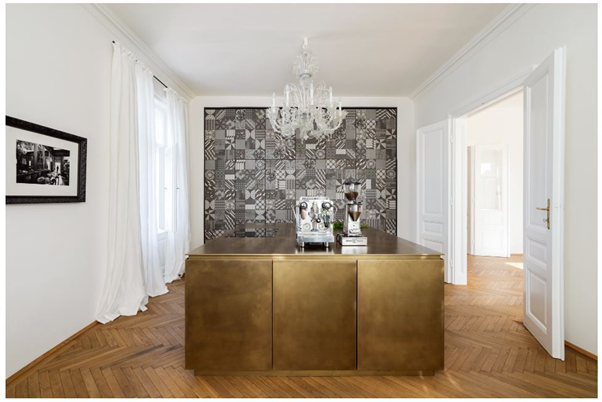
The flooring could enhance or ruin a home’s look. Cheap-looking tile and poor carpeting have dragged down some lovely homes, not to add the enormous expense of restoring worn-out or damaged flooring. Meanwhile, entering a property with flooring or walls that have extraordinarily gorgeous handmade vintage tiles is incredible. Encaustic tiles are increasingly becoming popular in houses around the globe, and anyone wishing to rebuild, restore, or create new homes or businesses must take notice.
What Are Encaustic Tiles?
Encaustic tiles are eye-catching, geometric tiles that come in two to six hues. Unlike glazed designs that rest on the tile’s surfaces, the colours flow into it and will not fade out over time. Furthermore, even though encaustic tiles have been around for decades, their solid graphic designs and rich colours give them a desirable option for classic and modern houses. They may be used alone or in conjunction with other tiles, including tessellated tiles, to produce a more detailed, ornamental design.
How Do Encaustic Tiles Get Made?
Producing an encaustic tile is a time-consuming procedure. Tiles are constructed of cement, and every portion of the design is inserted into a design mould before being squeezed together and cooked in furnaces. The mould is built upside down to guarantee that the end product has a flawless top surface. To generate the proper tones for every pattern, cement, powdered marble, porcelain, and other colours are blended.
Are Encaustic Tiles Available in a Variety of Textures?
Encaustic tiles are often constructed of cement or porcelain. While one encaustic tile may seem similar to the other at first sight, the material used and how the design is created significantly impacts the tile’s function and durability. Some of the possible variations include the following:
Cement Encaustic Tiles
Moroccan cement encaustic is among the industry’s most popular varieties of encaustic, with the design etched into the tile’s surface when burned. These imprinted cement tiles are reasonably cheap; however, they are highly porous, discoloured, chip quickly, cannot withstand intense foot activity, and need frequent sealing.
Glazed Porcelain Encaustic Tiles
The glazed porcelain tile with a stylish appearance etched on the surface is now the industry’s most prevalent encaustic. While manufacturing quality varies in terms of quality and design, typically, these devices are robust, adaptable, simple to clean, suitable for floors and walls, and several have an R11 certification, allowing them to be utilised outdoors.
Where Can You Utilise Encaustic Tiles in Your Home?
Outdoor patio tiles, fireplaces, paths, hallways, swimming pool covers, kitchens, and bathrooms are just a few places where encaustic tiles may be utilised to create a great aesthetic impact. The trick is to select the appropriate tile materials for the project.
How Do You Select the Best Encaustic Tiles for Outdoor Spaces?
Amazing encaustic tiles are intricate to the top when it comes to upping the design quotient of your swimming pool surround, outdoor tiles, and front walk. They can also survive adverse weather conditions when properly picked and will appear and function brilliantly for decades.
Furthermore, safety should be your top priority in a damp location with high foot traffic. You will need non-slip tiles which are also resilient to breaking and chipping. They also need to be simple to clean, fade-resistant, and long-lasting. Fully vitrified porcelain meets all the criteria and is assured to look for a long time. Compressed porcelain encaustic tiles are ideal for high-traffic locations like a front walk or patio.
How to Care About Your Encaustic Tiles
Encaustic tiles may resist outdoor conditions in well-protected areas, such as a patio area or a deck in a European environment. Nonetheless, since these tiles are somewhat porous, they could develop minor fractures or chipping when exposed to ice or get blocked with humidity.
To assist in alleviating these frost-related difficulties, experts recommend the following:
- Install the tiles on a concrete substrate that is waterproof or impermeable.
- Set the tiles with a second layer of adhesives; otherwise, pockets of water beneath the tiles might cause them to lose or break in the case of freezing.
- Utilise outdoor-appropriate adhesive.
- To minimise water penetration, the joints should be well-constructed and well-maintained.
- A suitable gradient is essential to drain water and avoid puddles swiftly.
- Aside from adequate drainage, experts suggest to re-seal the tiles on a routine basis.
Are Encaustic Tiles Expensive?
Despite what certain firms charge, only some encaustic tiles are costly, and even though encaustic tiles are specialised items, the advantages exceed the extra cost. Note that you will be utilising the area for several years. Engaging in high-quality encaustic tiles provides a long-lasting substance that outlasts most other tile selections. Encaustic tiles may also significantly increase the worth of your house or business space since the new owners will have fewer to do when they move in, and contributing positively to the area is always a plus.
Conclusion
Encaustic tiles allow you to create a unique and unusual statement. The patterns’ colours and characteristics enable an infinite number of setup choices, making them suitable for every environment. They are the perfect approach to creating a one-of-a-kind setting. You would be provided with several floor alternatives when repairing or creating outdoor patio tiles. Remember that you’ll like your outdoor tiles shining out and representing your character or company. Relying solely on a mass-produced choice from a well-known home improvement shop may be a low-cost alternative. These ready-made solutions make replacing damaged tiles simpler, but their actual distinctive quality is never a possibility.








